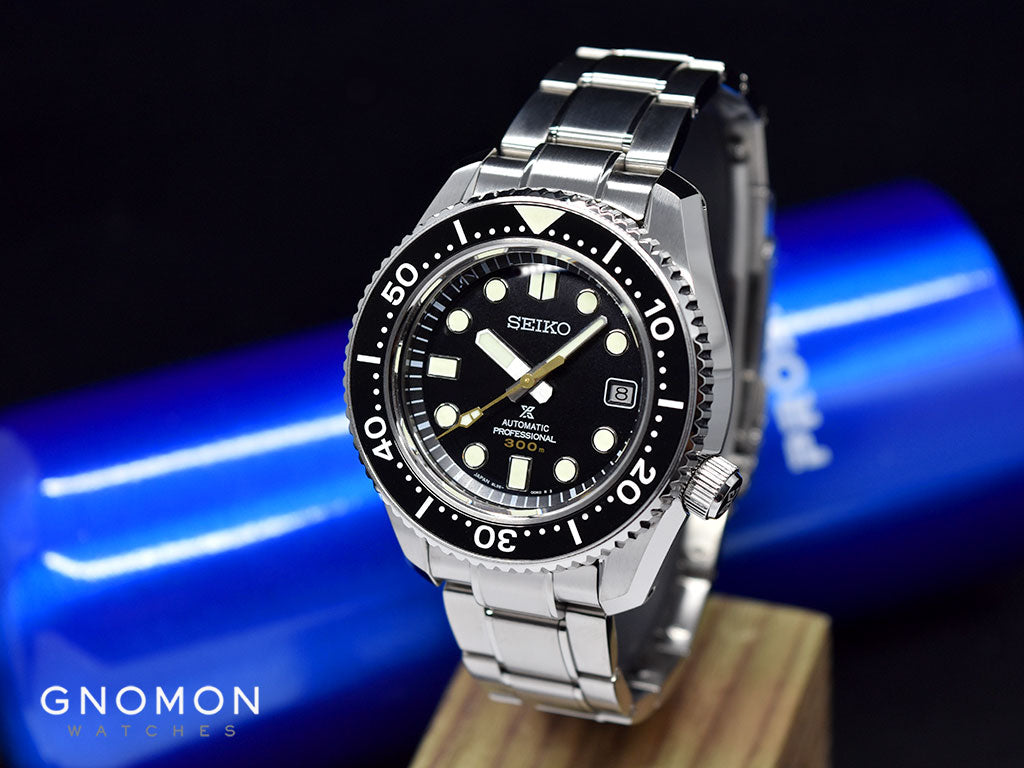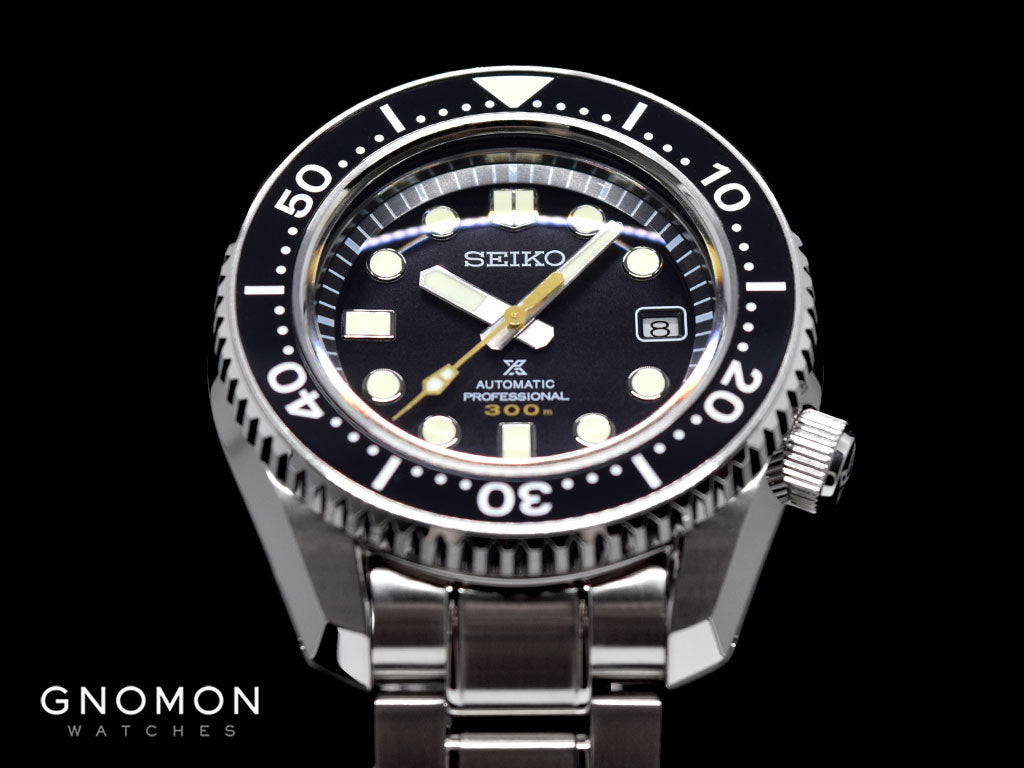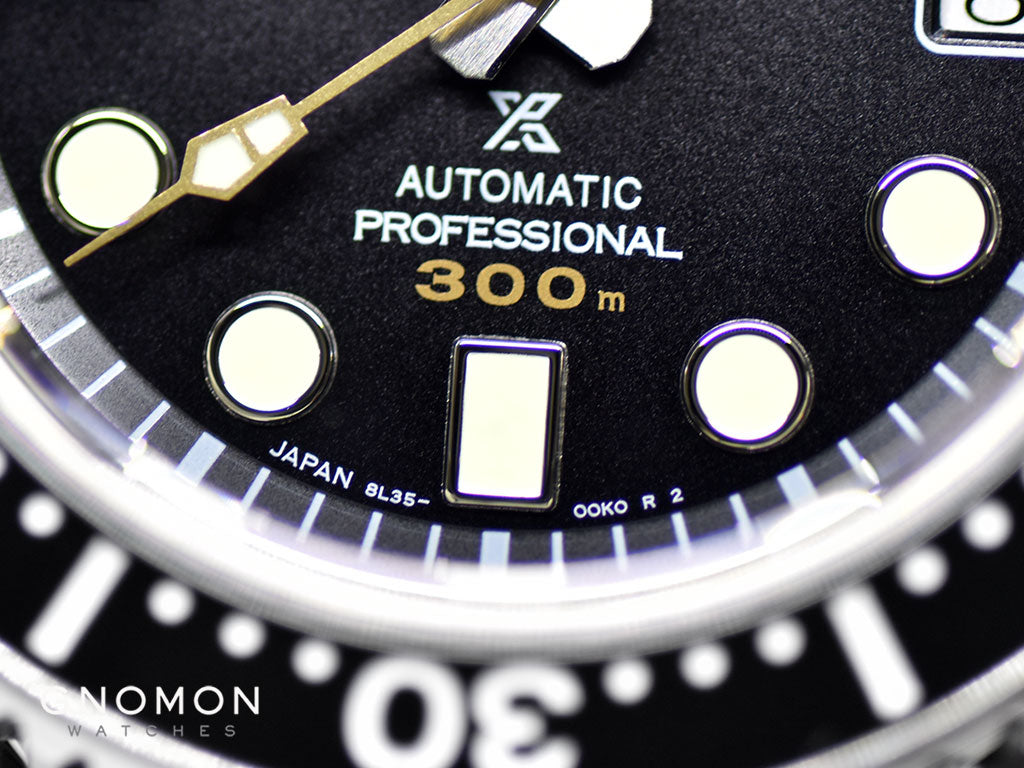Nothing in cart

History of Seiko and Marine Master Family Watch Review
Introduction: Seiko in History
For professionals, weekend adventurers, and everything in between, Seiko has a long history of creating the ideal dive watch. In this three-part series, we'll take a look at the history of three different groups of dive watches under the Seiko umbrella - watches so iconic and cherished by watch enthusiasts that many have their own unofficial nicknames - and trace their evolution down to this time. modern, advanced technology, Prospex iteration.
Japan has always been hard at work with diving watches. They've definitely released a number of them, and the models range from Swiss watch tributes, to avant garde designs with limited appeal. The Citizen Aqualand series has always been very functional. On the other hand Seiko has released a number of dive watches, some with names like Samurai and Monster. Again, some are good, some may not suit my taste, but I believe each one is reliable. The Japanese are always playing around with the various movements in dive watches (all their watches for that matter). I've seen at least six different styles of movements on Japanese dive watches (quartz, Eco-Drive, Kinetic, Kinetic Direct Drive, Spring Drive, and Auto). The last four movements are at least somewhat mechanical. However, Japan is the only country besides Germany and Switzerland that can design and manufacture mechanical movements of reliable quality on any mass scale.
Previously, we looked at the Turtle diver family, a highly functional watch made for everyday use, ideal for recreational divers and watch lovers who need a watch that is sturdy and durable. Today, we take a look at the Marinemaster lineup, and Seiko's history of superior diving watches designed for professionals who risk their lives in the deep sea every day.
The 1960s were the golden age for functional watches. Long before watches became collectibles valued for their rarity, they were purpose-driven instruments intended to perform a specific job. In the 60's, a new job that required special tools and brave workers was professional diving. The planet's oceans, which hold large reserves of untapped natural resources, became fertile ground for exploration in the years following World War II, with technology finally being able to (somewhat) safely keep divers submerged for increasingly longer periods of time. For these professional divers, a reliable timekeeping instrument is essential, as untimely decompression stops can easily lead to bends, or worse. Constant dive time monitoring is an obvious necessity to stay alive underwater, and Seiko has served divers from the start with a distinct line of watches designed for the most serious of professionals, consistently focused on combining the most innovative designs and cutting edge horology technologies.
In 1967, Seiko introduced its first professional diving watch, the 6215-7000. While Seiko has made watches meant for diving before, the 6215-7000 is something entirely different. This watch is not intended for enthusiasts of casual recreational diving, but for divers who make their living by diving perilous. While early Seiko dive watches had a water resistance rating of 150 meters, the 6215-7000 was able to withstand depths of up to 300 meters. It achieves this (at the time of eye-popping) partial water resistance through the unique monocoque, or one piece, casing construction, keeping the possible entry points of water to a minimum. The 6215-7000 is also the first Seiko dive watch to have a crown at 4 o'clock, which has remained a Seiko diver trademark to this day, and offers a strong aesthetic link between early skilled diver watches and today's highly sophisticated Prospex divers.
The 6215-7000 was only in production for a year before being replaced by the 6159-7001. It is one of Seiko's most collectible dive watches. The new version is nearly identical in appearance and construction to the 6215-7000, but features high-frequency motion operating at 36,000 bph. The high-beat moves have become something special to Seiko, offering better speed precision and stability over time compared to movements that run at more traditional frequencies. Typically, movements are more difficult to manufacture and properly tune than standard movements, but over the decades, Seiko has been a leader in the manufacture and proper adjustment of high-frequency movements. The 1968 introduction of 6159-7001 was a real milestone in the making clock, and it is considered the world's first high knock diving watch.
The Marinemaster Watch
So in the picture Seiko Marinemaster is one of Seiko's finest automatic movement. The 8L35 is automatic with 26 Gems and a 50 hour power reserve. The accuracy easily matches the level of a certified chronometer, and often exceeds that level. The chronometer, for example, is accurate in 6 seconds per day on average, while the Seiko 8L35 is accurate in 10-15 seconds per month. Pretty good for mechanical automatic movement.

This watch is different from the other Seiko Prospex Marinemaster watches I have talked about. It has Kinetic Direct Drive or Spring Drive movements rather than automatic movements. For example, I'm talking about the look-alike Seiko SBDD001, which has a similar name, but different looks and movements. The Seiko SBDX023 is an excellent offering from Seiko for a number of reasons.

This early professional dive watch laid the groundwork for what the public expected from the leading and distinguished divers of Seiko. The SBDX023 Marinemaster 300 is the logical next step in the Seiko professional diver chain, providing the clearest link to the modern watch on the Prospex line today. While the SBDX023 is produced exclusively for the Japanese market, many are imported to the United States and elsewhere, offering clear value over the much more expensive Swiss competitors. The construction, still monocoque, is extraordinary, and by the time this watch appears in the early 21st century, the basic physics behind the case design has been proven for a generation, and has been further refined along with Seiko's manufacturing capabilities. and techniques grow and become more advanced. The SBDX023 is not only an essential tool for divers, but represents the pinnacle of engineering for Seiko obsessives around the world.

Constant monitoring of dive times is an obvious necessity to stay alive underwater, and Seiko has served divers since its inception. consistently focuses on combining the most innovative designs and cutting edge horology technologies.
Seiko Marine Master's Appearance
The Marinemaster has a similar shape to previous professional dive watches, but the overall quality of the finish is sharper than the true vintage model, thanks to production beginning in the SBDX023 in 2000. Viewing the case in profile or from an angle reveals a smooth but well-executed transition between a polished and brushed surface, with its ultra-thin bevels and flowing, graceful outline of the casing. The engine that powers the Marinemaster is the 8L35 caliber.

With a revived interest in vintage watches, the Prospex line has produced a collection of ultramodern divers that take several design cues from the Marinemaster, 6159, and 6215 from Seiko's back catalog while offering only the best in current watchmaking technology.

The Seiko SBDX023 is the only Marinemaster watch that actually reads "Marinemaster" on the watch. Seiko has never been known for naming their watches artfully, so be aware that this watch is Seiko, in the Prospex lineup, which is Marinemaster, and is the model number SBDX023. Know that you can find it at the Gnomon shop. In fact, you don't have to go to Japan to get them, they are available online with free shipping.
Movement
What I really like about this watch is its compact design and good features. To me, this is what a classic Japanese mechanical dive watch looks like. Seiko was finally able to take everything people love about a Japanese-style dive watch and put it together into one watch that truly characterizes its theme. You don't buy a Japanese knockoff Swiss watch, you get something that is purely Japanese refinement from the dial and hands display to the philosophy in the movement (which has a very fine second hand unlike the cheaper automatic movements). Seiko's watches have always preferred functionality over form, but styles have evolved over time. One of these elements is the 4-crown clock position, as well as the large numeric index and meaningless bezel. On the inside, you'll see a slanted chapter circle with a minute increment mark that makes the watch easy to read, and just happens to add a nice 3-D display to the watch. Furthermore, the rich luminant on the face and hands is a bright plus as seen in the video above.
One of Seiko's main strengths is recognizing when and how to reintroduce classic designs to the market. With SLA025, the limited edition released in 2018 of only 1,500 pieces, the brand is paying tribute to the legendary 6159-7001. The watch's full name, 1968 Auto Diver Remake Limited Edition, shows the essence of what the SLA025 is and what Seiko is capable of digging through the archives. This timepiece lives up to the original in all the important details, from the distinctive hands set to the 4 o'clock crown to the classic case shape. The SLA025 is equipped with Seiko's Hi-Beat 8L55 movement, a logical choice given the importance of the 6159-7001's ability to carry high-frequency caliber to the depths of the world's oceans. At the 2018 Grand Prix d'Horlogerie de Genève, SLA025 was also awarded the prestigious Sports Watch Prize.
If you miss SLA025, or miss the great example of old Seiko diver but can't part with the five numbers that are often needed to get the best of work, the Prospex SBDC061 is a must-have. Based on the 6159 design, the SBDC061 is an excellent modern interpretation of the classics. While the dial details, the dials of the 4 dials, and the outline of the case all clearly reminds us of the 6159, the SBDC061 is a modern watch in vintage clothing - the bezels look very shiny, offering a distinct flair from the cooler examples of vintage models, and the case is made in a traditional three-piece design, accessible from the back, unlike the monocoque cases of the past. The end result is a sleek and modern remodeling of the watch that is an important part of Seiko's history, and although it has benefited from the ornamentation of modern manufacturing techniques, it has not lost its original charm.
 Seiko SBDC061 "Baby MM"
Seiko SBDC061 "Baby MM"
Dial
While the SBDC061 is a tribute watch that has its own set of settings in a professional diving setting, the SLA021 can be considered the uncompromising modern heir to all that Marinemaster represents. Although the dial does not say "Marinemaster", the cultural heritage here cannot be denied. The SBDX023 is very similar, but with the modern Prospex features that set it apart. The bezel insert, traditionally made of scratchable aluminum, is now ceramic, while the finish of the case makes use of Seiko's finest Zaratsu polishing techniques, giving this technically sophisticated timepiece a mirror-like luster and an unusual level of smoothness.

Since the advent of professional diving, Seiko has been at the forefront of creating the timepiece divers need to do their job safely.
At the top of Seiko's range of professional divers is the GPHG award-winning Prospex LX SNR029. Although, on the surface, this could easily be mistaken for SLA021, this is a completely different animal. The power reserve on the dial provides no small secret - it's powered by the Spring Drive caliber. Since the advent of quartz, Seiko's most significant watchmaking achievement has been Spring Drive. Combining a mechanical gear train with electronic timing, Spring Drive is more than just a "best of both worlds" option; it is a distinct step forward in watchmaking technology, and as used in professional dive watches represents a new standard not only in timekeeping, but also in safety. With an accuracy of +/- 1 second per day (+/- 15 seconds per month), the reliability and precision of Spring Drive technology will give professional divers confidence as they get down to complete the dangerous work they are doing.
 Seiko Prospex Marinemaster SNR029
Seiko Prospex Marinemaster SNR029
The SNR029 also differs from other watches in this area of the Prospex range in the material of the case. Crafted from titanium, the SNR029 is significantly lighter on the wrist compared to steel, making it a versatile and ergonomic choice. Although the SNR029 is not a small watch, the lightweight materials used make it wearable for almost anyone, either far below sea level or above. The natural gray hue of the titanium gives the watch an instrument-like appearance, but the finish is still Seiko's signature, one might say, without compromise. It's impressive that the craftsmen behind the finishing of the Seiko case were able to make this very industrial material look gorgeous.

Since the advent of professional diving, Seiko has been at the forefront of creating the timepiece divers need to do their job safely. From the high frequency divers of the early '60s, to the Marinemaster, to the modern Prospex range of professional divers, Seiko leaves nothing on the tech table to bring their customers the most useful instruments to excel at their job.
Prices and Perks
The Seiko Marinemaster SNR029 costs around $5,480.00 USD retail and is a good value considering all the high points. The price for Marine Master SBDC061 is $820.00 USD. While for the Marine Master SBDX023 costs $2,790.00 USD.
Watches are not perfect, because there are only a few watches. Although it allows me to clear up a few things. This watch has a water resistance of 300m. Some may be wondering why not go deeper into the money. Well, unless you like seeing big numbers written on a watch, consider how often if your body wouldn't just dive that deep, and survive. So 300m will satisfy whatever you need. The watch is heavy too. To be sturdy and reliable, Marinemaster is basically a lump of solid steel. It's over 200 grams and the size is about 44mm. If you want to reduce weight, you can wear the rubber strap that comes with the metal bracelet. Furthermore, you can wear the watch for a few days until your weak wrist adapts. Seriously, that's all it takes to adjust to a heavier watch.
Strap
Lastly, the only real complaint that can be justified is the bracelet. Let me start by saying that this Seiko Marinemaster bracelet is super cool. It features a ratcheting system for easy installation and adjustment, which I really like. The thing is, Japanese wristbands have never matched the refinement and quality of their European competitors. They are not very liquid or feel solid. It's not about comfort, but expecting a Swiss watch over $ 5,000 usually has a very impressive bracelet. One day, the Japanese will be looking for a way to match Swiss and German bracelets, and at a lower cost. But until then, you should know that Europeans have a Japanese punch on that end.

The Seiko Prospex Marinemaster is a great addition to any collection, especially those who love Japanese or dive watches. It is one of those perfect everyday watches that will dutifully see its owner through any occasion. One thing this watch communicates to me through its European cousin is "my rough." In a good way. A good Japanese watch always seems ready for duty and able to take whatever you can throw at it, while Swiss watches make me want to shield them from the elements and harm to preserve their appearance. This is one of the reasons high-end Japanese watches like this call me, and why it should call you too.




